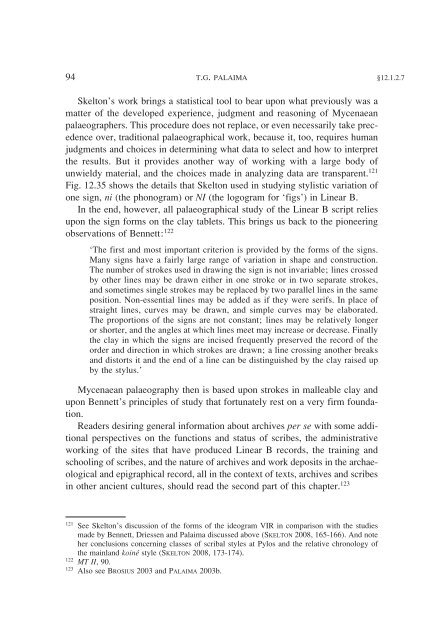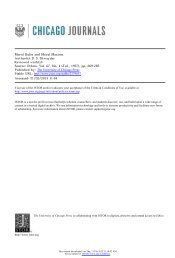A Companion to Linear B - The University of Texas at Austin
A Companion to Linear B - The University of Texas at Austin
A Companion to Linear B - The University of Texas at Austin
Create successful ePaper yourself
Turn your PDF publications into a flip-book with our unique Google optimized e-Paper software.
94 T.G. PALAIMA §12.1.2.7<br />
Skel<strong>to</strong>n’s work brings a st<strong>at</strong>istical <strong>to</strong>ol <strong>to</strong> bear upon wh<strong>at</strong> previously was a<br />
m<strong>at</strong>ter <strong>of</strong> the developed experience, judgment and reasoning <strong>of</strong> Mycenaean<br />
palaeographers. This procedure does not replace, or even necessarily take precedence<br />
over, traditional palaeographical work, because it, <strong>to</strong>o, requires human<br />
judgments and choices in determining wh<strong>at</strong> d<strong>at</strong>a <strong>to</strong> select and how <strong>to</strong> interpret<br />
the results. But it provides another way <strong>of</strong> working with a large body <strong>of</strong><br />
unwieldy m<strong>at</strong>erial, and the choices made in analyzing d<strong>at</strong>a are transparent. 121<br />
Fig. 12.35 shows the details th<strong>at</strong> Skel<strong>to</strong>n used in studying stylistic vari<strong>at</strong>ion <strong>of</strong><br />
one sign, ni (the phonogram) or NI (the logogram for ‘figs’) in <strong>Linear</strong> B.<br />
In the end, however, all palaeographical study <strong>of</strong> the <strong>Linear</strong> B script relies<br />
upon the sign forms on the clay tablets. This brings us back <strong>to</strong> the pioneering<br />
observ<strong>at</strong>ions <strong>of</strong> Bennett: 122<br />
‘<strong>The</strong> first and most important criterion is provided by the forms <strong>of</strong> the signs.<br />
Many signs have a fairly large range <strong>of</strong> vari<strong>at</strong>ion in shape and construction.<br />
<strong>The</strong> number <strong>of</strong> strokes used in drawing the sign is not invariable; lines crossed<br />
by other lines may be drawn either in one stroke or in two separ<strong>at</strong>e strokes,<br />
and sometimes single strokes may be replaced by two parallel lines in the same<br />
position. Non-essential lines may be added as if they were serifs. In place <strong>of</strong><br />
straight lines, curves may be drawn, and simple curves may be elabor<strong>at</strong>ed.<br />
<strong>The</strong> proportions <strong>of</strong> the signs are not constant; lines may be rel<strong>at</strong>ively longer<br />
or shorter, and the angles <strong>at</strong> which lines meet may increase or decrease. Finally<br />
the clay in which the signs are incised frequently preserved the record <strong>of</strong> the<br />
order and direction in which strokes are drawn; a line crossing another breaks<br />
and dis<strong>to</strong>rts it and the end <strong>of</strong> a line can be distinguished by the clay raised up<br />
by the stylus.’<br />
Mycenaean palaeography then is based upon strokes in malleable clay and<br />
upon Bennett’s principles <strong>of</strong> study th<strong>at</strong> fortun<strong>at</strong>ely rest on a very firm found<strong>at</strong>ion.<br />
Readers desiring general inform<strong>at</strong>ion about archives per se with some additional<br />
perspectives on the functions and st<strong>at</strong>us <strong>of</strong> scribes, the administr<strong>at</strong>ive<br />
working <strong>of</strong> the sites th<strong>at</strong> have produced <strong>Linear</strong> B records, the training and<br />
schooling <strong>of</strong> scribes, and the n<strong>at</strong>ure <strong>of</strong> archives and work deposits in the archaeological<br />
and epigraphical record, all in the context <strong>of</strong> texts, archives and scribes<br />
in other ancient cultures, should read the second part <strong>of</strong> this chapter. 123<br />
121 See Skel<strong>to</strong>n’s discussion <strong>of</strong> the forms <strong>of</strong> the ideogram VIR in comparison with the studies<br />
made by Bennett, Driessen and Palaima discussed above (SKELTON 2008, 165-166). And note<br />
her conclusions concerning classes <strong>of</strong> scribal styles <strong>at</strong> Pylos and the rel<strong>at</strong>ive chronology <strong>of</strong><br />
the mainland koiné style (SKELTON 2008, 173-174).<br />
122 MT II, 90.<br />
123 Also see BROSIUS 2003 and PALAIMA 2003b.

















